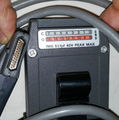308: Difference between revisions
m (Text replacement - "Category:Logic Analyzers" to "Category:Logic analyzers") |
No edit summary |
||
| Line 10: | Line 10: | ||
* [[Media:070-2662-00.pdf | Tek 308 Service manual (PDF, OCR, 13MB)]] | * [[Media:070-2662-00.pdf | Tek 308 Service manual (PDF, OCR, 13MB)]] | ||
* [[Media:Tek_308_logic_analyzer_+_probes_(1979)_SM.pdf | Tek 308 Service manual + probes (PDF, OCR, 19MB)]] | * [[Media:Tek_308_logic_analyzer_+_probes_(1979)_SM.pdf | Tek 308 Service manual + probes (PDF, OCR, 19MB)]] | ||
====ROM images==== | |||
* [[Media:160-0768-00.bin|160-0768-00.bin]] U430 - 0x0000 | |||
* [[Media:160-0769-00.bin|160-0769-00.bin]] U432 - 0x2000 | |||
* [[Media:160-0770-00.bin|160-0770-00.bin]] U434 - 0x4000 | |||
* [[Media:160-0797-00.bin|160-0797-00.bin]] U486 - CharGen | |||
}} | }} | ||
The '''Sony/Tektronix 308''' is a portable 8-channel, 20 MHz "data analyzer" (logic analyzer) with parallel timing, parallel state, serial (up to 9600 bps) and signature analysis modes. | The '''Sony/Tektronix 308''' is a portable 8-channel, 20 MHz "data analyzer" (logic analyzer) with parallel timing, parallel state, serial (up to 9600 bps) and signature analysis modes. | ||
Revision as of 15:41, 10 November 2020
The Sony/Tektronix 308 is a portable 8-channel, 20 MHz "data analyzer" (logic analyzer) with parallel timing, parallel state, serial (up to 9600 bps) and signature analysis modes.
The 308 uses two probes, the standard P6451 8-channel + clock data acquisition probe, and the optional 16-channel P6406 word recognizer probe. Both use 012-0747-00 cable harnesses to attach to the data source.
Key Specifications
| — Inputs — | |
| Data | Eight data channels + 1 clock channel (P6451 probe), impedance 1 MΩ // 5 pF, max. ±40 V nondestructive, logic threshold fixed 1.4 V (TTL) or variable from −12 V to +12 V |
| Word recognizer | Sixteen TTL inputs (+40/−400 μA max.), max. +15/−1 V |
| Serial | BNC connector, 1 MΩ // 40 pF, max. ±250 V on BNC; used with P6107 probe, 10 MΩ // 13 pF, max. ±500 V |
| Qualifier | BNC connector, 10 kΩ, max. +10/−5 V |
| — Acquisition — | |
| Clock | 50 ns to 200 ms per sample (1-2-5 sequence) or external down to 50 ns |
| Timing | Data setup time min. 25 ns, hold time min. 0 ns |
| Memory | 2 × 252 eight-bit words (acquisition + reference) |
| Trigger mode | PRE (trigger at memory location 240) or POST (location 13) |
| Trigger delay | 0-65535 clock periods |
| Serial data | 5, 6, 7 or 8 bits per character, asynchronous (50, 75, 110, 134.5, 150, 200, 300, 600, 1200, 1900, 2400, 4800 or 9600 bits/s or external up to 9600 bits/s) or synchronous up to 9600 bits/s |
| — Display — | |
| CRT | 6.8 cm × 5.4 cm, P4 phosphor (white) |
| — General — | |
| Power | 90-132 V or 180-250 V, 48-440 Hz |
| Weight | 3.7 kg (8.16 lb) |
Links
- Tekscope Vol. 12 No. 2, Apr 1980, Ed Averill, John Huber: Portable Data Analyzer Speeds Test and Service of Microprocessor-Based Systems
- Tek 308 @ radiomuseum.org
- Tek 308 @ barrytech.com
Internals
The 308 is built around an Intel 8085A microprocessor. The display is a magnetically deflected raster-scan CRT. The only Tek-specific IC in the 308 is a 155-0067-02 SMPS controller.
Pictures
-
308 display, timing mode (binary counter example)
-
308 display, state mode (binary counter example)
-
-
-
-
-
-
-
-
-
-
-
-
Internals
-
Top left
-
Top right
-
Top right (2)
-
Boards unfolding
-
Boards unfolding (2)
-
Input board
-
Trigger board
-
back side of input and trigger boards
-
Signature/Serial board
-
CPU board
-
CRT module
-
Power supply, top
-
Power supply, bottom
-
Bottom (CRT board and card cage)
Probes




































